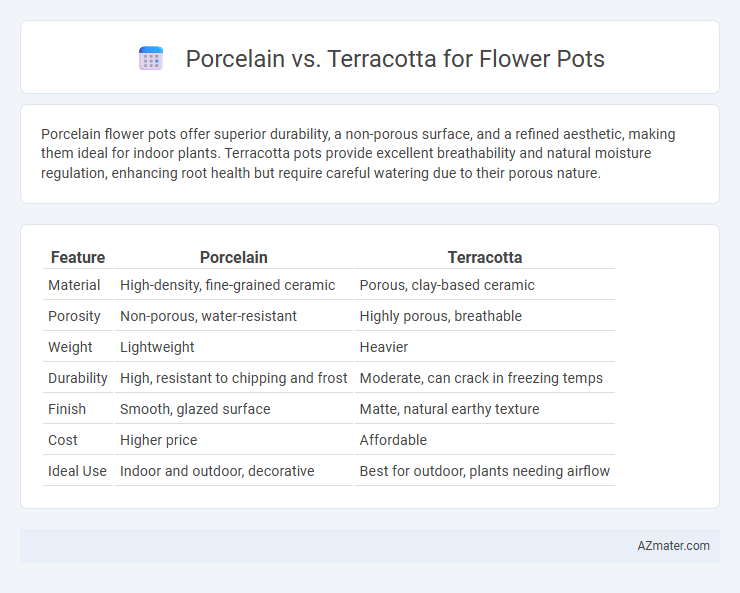Porcelain flower pots offer superior durability, a non-porous surface, and a refined aesthetic, making them ideal for indoor plants. Terracotta pots provide excellent breathability and natural moisture regulation, enhancing root health but require careful watering due to their porous nature.
Table of Comparison
| Feature | Porcelain | Terracotta |
|---|---|---|
| Material | High-density, fine-grained ceramic | Porous, clay-based ceramic |
| Porosity | Non-porous, water-resistant | Highly porous, breathable |
| Weight | Lightweight | Heavier |
| Durability | High, resistant to chipping and frost | Moderate, can crack in freezing temps |
| Finish | Smooth, glazed surface | Matte, natural earthy texture |
| Cost | Higher price | Affordable |
| Ideal Use | Indoor and outdoor, decorative | Best for outdoor, plants needing airflow |
Introduction to Porcelain and Terracotta Flower Pots
Porcelain flower pots are crafted from fine, high-temperature fired clay, resulting in a smooth, durable, and often glazed surface that offers excellent moisture retention and frost resistance. Terracotta flower pots are made from coarse, porous earthenware clay, which provides natural breathability for plant roots and promotes healthy soil aeration but requires more frequent watering due to its absorbent nature. Both materials cater to different gardening needs, with porcelain favoring decorative, long-lasting use and terracotta preferred for its classic aesthetic and natural ventilation properties.
Material Composition and Manufacturing Differences
Porcelain flower pots are made from refined clay and kaolin, fired at high temperatures above 1200degC, resulting in a dense, non-porous, and durable material with a smooth finish. Terracotta pots consist of natural clay fired at lower temperatures around 1000degC, producing a porous, breathable texture that allows air and moisture exchange, benefiting plant roots. The manufacturing process of porcelain involves longer firing and glazing steps for a vitrified surface, while terracotta undergoes simpler shaping and firing, preserving its porous structure.
Aesthetic Appeal: Porcelain vs Terracotta
Porcelain flower pots offer a sleek, glossy finish with intricate designs and vibrant colors, enhancing modern and minimalist garden aesthetics. Terracotta pots provide a warm, earthy texture and natural reddish-brown tones that complement rustic and traditional garden styles. The choice between porcelain and terracotta ultimately depends on the desired visual impact and garden theme.
Porosity and Water Retention Capabilities
Porcelain flower pots exhibit low porosity, which significantly reduces water absorption, leading to excellent water retention capabilities that help maintain consistent soil moisture levels for plants. In contrast, terracotta pots have high porosity, allowing for better air circulation but causing faster evaporation and drier soil conditions. Understanding the water retention differences between porcelain and terracotta is crucial for selecting the right pot based on a plant's moisture requirements.
Durability and Weather Resistance
Porcelain flower pots offer superior durability due to their dense, vitrified surface, making them highly resistant to chipping and cracking in harsh weather conditions. Terracotta pots, while porous and breathable for plant roots, are more prone to damage from frost and prolonged exposure to moisture, often leading to cracking or crumbling over time. Choosing porcelain ensures long-lasting performance in diverse climates, whereas terracotta suits drier environments but requires extra care in colder seasons.
Weight and Practical Handling
Porcelain flower pots are significantly lighter and more delicate compared to the heavier, sturdier terracotta pots, making porcelain easier to move and handle for indoor gardening. Terracotta pots offer excellent breathability and moisture regulation due to their porous nature but require more effort to lift and transport due to their dense, clay-based material. For practical handling, porcelain suits decorative, lightweight applications, whereas terracotta's durability favors outdoor use despite its added weight.
Impact on Plant Health and Growth
Porcelain flower pots offer excellent water retention and temperature regulation, creating a stable environment that promotes healthy root development and consistent moisture levels essential for plant growth. Terracotta pots are porous, allowing air and moisture to pass through, which enhances soil aeration and prevents root rot but may require more frequent watering to maintain adequate hydration. Choosing between porcelain and terracotta affects plant health by balancing moisture retention and soil aeration, directly influencing root vigor and overall growth.
Cost Comparison and Affordability
Porcelain flower pots generally cost more due to their refined manufacturing process and durability, making them a premium choice for gardeners seeking aesthetic appeal and long-lasting use. Terracotta pots offer a more affordable option, priced lower because of their natural clay composition and simpler production methods. For budget-conscious buyers, terracotta provides excellent value while porcelain suits those investing in decorative, high-end containers.
Maintenance and Cleaning Requirements
Porcelain flower pots require minimal maintenance due to their non-porous surface, making them easy to clean and resistant to stains and mold buildup. Terracotta pots, being porous, absorb moisture and dirt, necessitating regular cleaning to prevent salt and mineral deposits and occasional sealing to maintain durability. Both materials benefit from gentle scrubbing with mild soap and water, but porcelain's smooth glaze significantly reduces cleaning frequency and effort compared to terracotta.
Choosing the Best Flower Pot for Your Plants
Porcelain flower pots offer a sleek, non-porous surface that retains moisture effectively, making them ideal for plants requiring consistent hydration, while terracotta pots provide excellent breathability and drainage, preventing root rot in drought-tolerant plants. Choosing the best flower pot depends on your plant's water needs and environmental conditions; porcelain suits indoor plants needing steady moisture, whereas terracotta benefits succulents and herbs that thrive in well-aerated soil. Consider factors like pot weight, insulation properties, and aesthetic preferences alongside plant type to optimize growth and health.

Infographic: Porcelain vs Terracotta for Flower Pot
 azmater.com
azmater.com